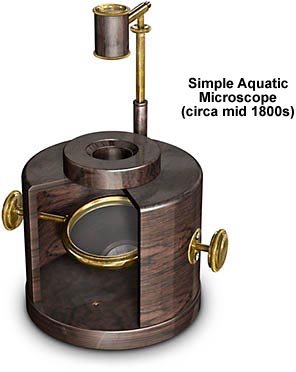Simple Aquatic Microscope
The specimen, usually an aliquot of pond water, is placed in a watchglass that is held in the central circular beveled wooden stage. The model illustrated below was redrawn from photographs of the original microscope, which was photographed and described by Gerard Turner in his excellent catalog of microscopes from the Institute and Museum of the History of Science in Florence, Italy.

The body of the microscope consists of a wooden cylinder, painted black, that holds a substage mirror housed on an axle with knobs at the ends for position adjustment. A Coddington-style lens is mounted in a brass tube that is positioned with a short bracket attached to the microscope arm. The lens is made from a block of glass that has a v-shaped section cut around the center, and provides about 3x magnification. As discussed by Turner, the Coddington lens is named after Henry Coddington, a Cambridge University mathematics tutor, who published this design in 1829, although the actual inventor was David Brewster, who invented the lens in 1820.
BACK TO NINETEENTH CENTURY MICROSCOPES
